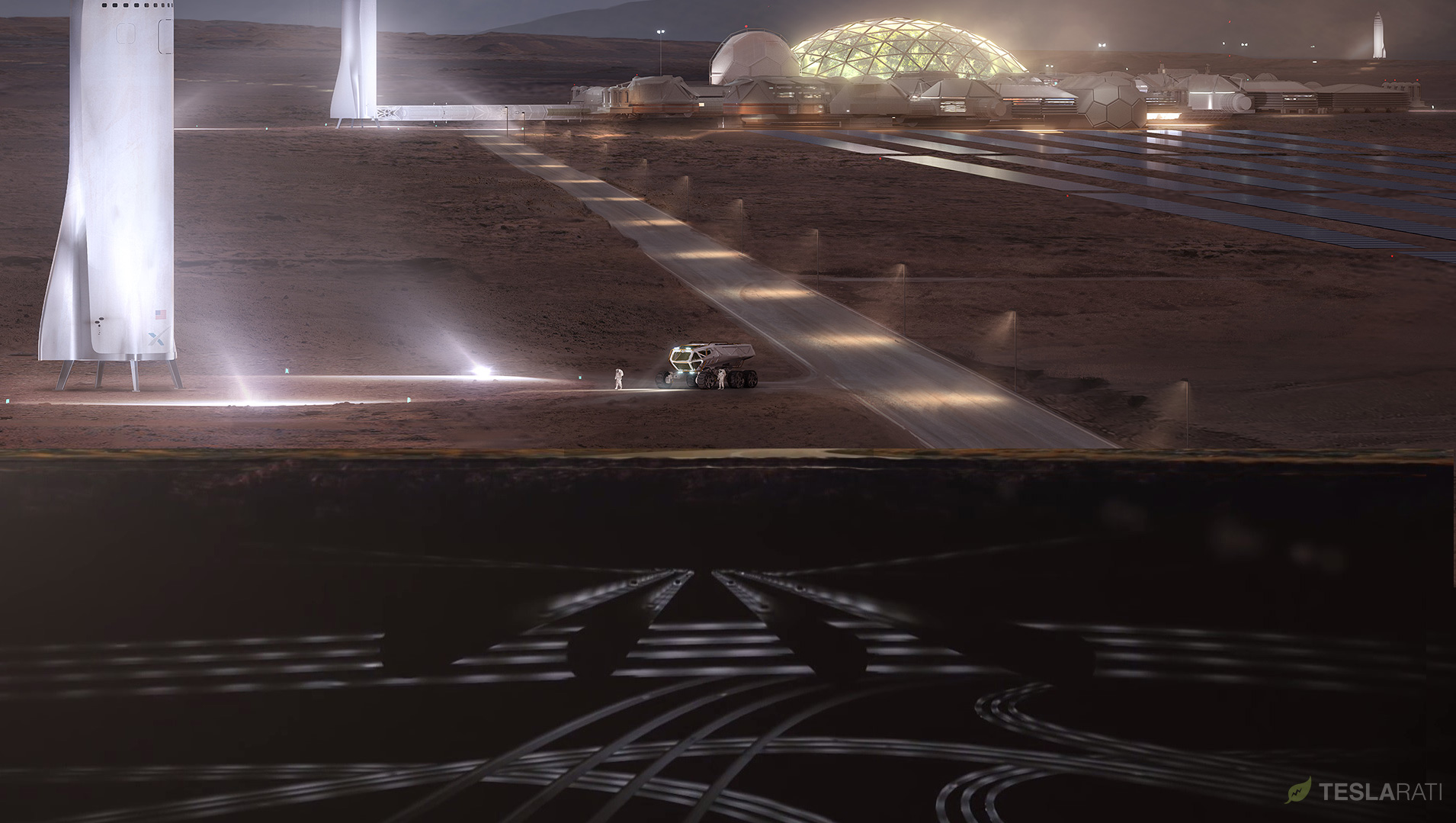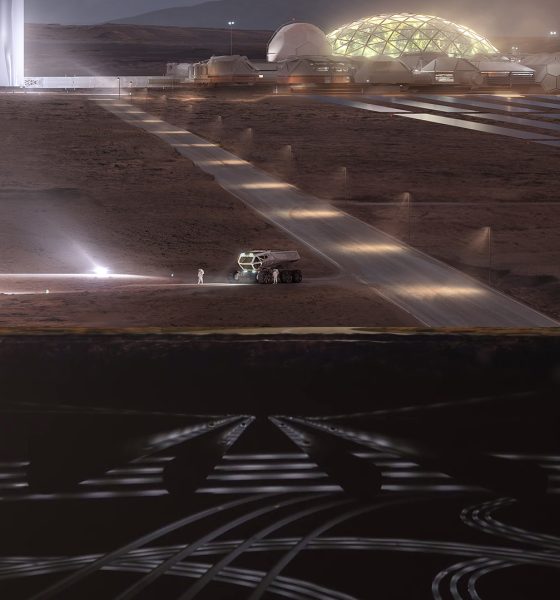

News
SpaceX to leverage Boring Co. tunneling tech to help humans settle Mars
SpaceX’s COO and President Gwynne Shotwell corroborated past comments made by CEO Elon Musk in a recent interview with CNBC, stating that she believed The Boring Company’s advances in tunneling technology will help SpaceX safely house humans on Mars.
Asked more broadly about collaboration between Musk’s many ventures, ranging from Tesla to Neuralink, she noted that “The Boring Company could actually be how we house people on Mars,” while also noting that Tesla’s expertise in battery technology had already found a home inside SpaceX’s Falcon 9 rocket and Dragon spacecraft.
In the past, Musk has also expressed interest in and awareness of the many potential uses for advanced tunneling technologies on Mars and for settlement of the solar system more generally. Speaking at 2017’s International Space Station Research and Development Conference, the CEO was asked by an audience member whether The Boring Company was actually just a front to develop technology that would help SpaceX settle humans on Mars. He agreed, at least partially:
“I do think getting good at digging tunnels could be really helpful for Mars. It would be a different optimization for a Mars boring machine versus an Earth boring machine, [but] there’s going to be a [need for a] lot of…mining in general to get raw materials [and water ice]. And then, along the way, building underground habitats where you could get radiation shielding… you could build an entire city underground if you wanted to.”
Intriguingly, a brand new study based on long-term data gathered from the Curiosity Mars rover (also known as Mars Science Laboratory) showed that Mars’ radiation environment was significantly less hostile than many have baselined in analyses of human outposts on the planet. Combined with vast lava tubes nurtured by Mars’ intense volcanism and forgiving gravity one third that of Earth’s, underground Martian habitats may be unnecessary in the short term, although long-term radiation exposure will remain a concern for colonists settling on the Red Planet.
Put simply, the first trips to Mars with SpaceX’s BFR and BFS (Big F****** Rocket/Spaceship) could save vast amounts of precious mass by initially avoiding tunneling hardware in lieu of more versatile supplies, saving lightweight Mars-optimized TBMs for future cargo transport missions. This would also give SpaceX, Tesla, and The Boring Company additional time to perfect tunneling on Earth and to hone their synergistic battery and materials expertise. As such, past and present comments made by Musk and Shotwell likely indicate a long-term perspective, sketching out a rough outline of potential strategies they believe can help enable a permanent human presence beyond Earth, particularly the colonization of Mars.
While not yet utilizing the much larger BFS, SpaceX’s first ventures into the world of human spaceflight could begin in less than a year, per the company’s internal H1 2019 target for its first crewed Crew Dragon mission to the International Space Station. Recently, Musk revealed the first photo of of a flightworthy Crew Dragon spacecraft, set to conduct its own uncrewed test flight near the end of 2018.

Elon Musk
Starlink passes 9 million active customers just weeks after hitting 8 million
The milestone highlights the accelerating growth of Starlink, which has now been adding over 20,000 new users per day.

SpaceX’s Starlink satellite internet service has continued its rapid global expansion, surpassing 9 million active customers just weeks after crossing the 8 million mark.
The milestone highlights the accelerating growth of Starlink, which has now been adding over 20,000 new users per day.
9 million customers
In a post on X, SpaceX stated that Starlink now serves over 9 million active users across 155 countries, territories, and markets. The company reached 8 million customers in early November, meaning it added roughly 1 million subscribers in under seven weeks, or about 21,275 new users on average per day.
“Starlink is connecting more than 9M active customers with high-speed internet across 155 countries, territories, and many other markets,” Starlink wrote in a post on its official X account. SpaceX President Gwynne Shotwell also celebrated the milestone on X. “A huge thank you to all of our customers and congrats to the Starlink team for such an incredible product,” she wrote.
That growth rate reflects both rising demand for broadband in underserved regions and Starlink’s expanding satellite constellation, which now includes more than 9,000 low-Earth-orbit satellites designed to deliver high-speed, low-latency internet worldwide.
Starlink’s momentum
Starlink’s momentum has been building up. SpaceX reported 4.6 million Starlink customers in December 2024, followed by 7 million by August 2025, and 8 million customers in November. Independent data also suggests Starlink usage is rising sharply, with Cloudflare reporting that global web traffic from Starlink users more than doubled in 2025, as noted in an Insider report.
Starlink’s momentum is increasingly tied to SpaceX’s broader financial outlook. Elon Musk has said the satellite network is “by far” the company’s largest revenue driver, and reports suggest SpaceX may be positioning itself for an initial public offering as soon as next year, with valuations estimated as high as $1.5 trillion. Musk has also suggested in the past that Starlink could have its own IPO in the future.
News
NVIDIA Director of Robotics: Tesla FSD v14 is the first AI to pass the “Physical Turing Test”
After testing FSD v14, Fan stated that his experience with FSD felt magical at first, but it soon started to feel like a routine.

NVIDIA Director of Robotics Jim Fan has praised Tesla’s Full Self-Driving (Supervised) v14 as the first AI to pass what he described as a “Physical Turing Test.”
After testing FSD v14, Fan stated that his experience with FSD felt magical at first, but it soon started to feel like a routine. And just like smartphones today, removing it now would “actively hurt.”
Jim Fan’s hands-on FSD v14 impressions
Fan, a leading researcher in embodied AI who is currently solving Physical AI at NVIDIA and spearheading the company’s Project GR00T initiative, noted that he actually was late to the Tesla game. He was, however, one of the first to try out FSD v14.
“I was very late to own a Tesla but among the earliest to try out FSD v14. It’s perhaps the first time I experience an AI that passes the Physical Turing Test: after a long day at work, you press a button, lay back, and couldn’t tell if a neural net or a human drove you home,” Fan wrote in a post on X.
Fan added: “Despite knowing exactly how robot learning works, I still find it magical watching the steering wheel turn by itself. First it feels surreal, next it becomes routine. Then, like the smartphone, taking it away actively hurts. This is how humanity gets rewired and glued to god-like technologies.”
The Physical Turing Test
The original Turing Test was conceived by Alan Turing in 1950, and it was aimed at determining if a machine could exhibit behavior that is equivalent to or indistinguishable from a human. By focusing on text-based conversations, the original Turing Test set a high bar for natural language processing and machine learning.
This test has been passed by today’s large language models. However, the capability to converse in a humanlike manner is a completely different challenge from performing real-world problem-solving or physical interactions. Thus, Fan introduced the Physical Turing Test, which challenges AI systems to demonstrate intelligence through physical actions.
Based on Fan’s comments, Tesla has demonstrated these intelligent physical actions with FSD v14. Elon Musk agreed with the NVIDIA executive, stating in a post on X that with FSD v14, “you can sense the sentience maturing.” Musk also praised Tesla AI, calling it the best “real-world AI” today.
News
Tesla AI team burns the Christmas midnight oil by releasing FSD v14.2.2.1
The update was released just a day after FSD v14.2.2 started rolling out to customers.

Tesla is burning the midnight oil this Christmas, with the Tesla AI team quietly rolling out Full Self-Driving (Supervised) v14.2.2.1 just a day after FSD v14.2.2 started rolling out to customers.
Tesla owner shares insights on FSD v14.2.2.1
Longtime Tesla owner and FSD tester @BLKMDL3 shared some insights following several drives with FSD v14.2.2.1 in rainy Los Angeles conditions with standing water and faded lane lines. He reported zero steering hesitation or stutter, confident lane changes, and maneuvers executed with precision that evoked the performance of Tesla’s driverless Robotaxis in Austin.
Parking performance impressed, with most spots nailed perfectly, including tight, sharp turns, in single attempts without shaky steering. One minor offset happened only due to another vehicle that was parked over the line, which FSD accommodated by a few extra inches. In rain that typically erases road markings, FSD visualized lanes and turn lines better than humans, positioning itself flawlessly when entering new streets as well.
“Took it up a dark, wet, and twisty canyon road up and down the hill tonight and it went very well as to be expected. Stayed centered in the lane, kept speed well and gives a confidence inspiring steering feel where it handles these curvy roads better than the majority of human drivers,” the Tesla owner wrote in a post on X.
Tesla’s FSD v14.2.2 update
Just a day before FSD v14.2.2.1’s release, Tesla rolled out FSD v14.2.2, which was focused on smoother real-world performance, better obstacle awareness, and precise end-of-trip routing. According to the update’s release notes, FSD v14.2.2 upgrades the vision encoder neural network with higher resolution features, enhancing detection of emergency vehicles, road obstacles, and human gestures.
New Arrival Options also allowed users to select preferred drop-off styles, such as Parking Lot, Street, Driveway, Parking Garage, or Curbside, with the navigation pin automatically adjusting to the ideal spot. Other refinements include pulling over for emergency vehicles, real-time vision-based detours for blocked roads, improved gate and debris handling, and Speed Profiles for customized driving styles.










